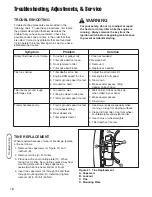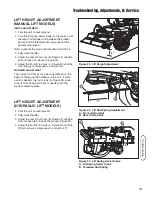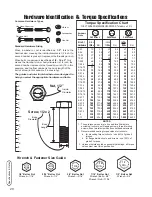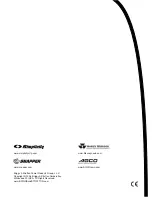
14
Operation
Operation
OPERATION
NOTICE
Refer to the Tractor Operator’s Manual for
important information concerning safely
operating your tractor.
CAUTION
After striking a foreign object, stop the engine,
disengage the PTO, and remove the key.
Inspect the tiller for damage before starting.
The tiller may propel the tractor forward when
first lowered into hard ground especially if tiller
depth is set too deep or tractor ground speed
is too fast.
Checks Before Starting
1. Make sure all covers and guards are in place.
Make sure all nuts, bolts, clevis pins, and clips
are secure.
2. The tiller must be lubricated before first use and
after every four hours of operation. If required,
see instructions in “Maintenance” section.
3. Clear the work area of any items that could be
caught in the tiller.
Transporting
When transporting the tiller to and from the work
area, the tiller should be fully raised. Adjust ground
speed according to condition of the ground surface.
Turning or Backing When Tilling
Before backing up or turning, raise the tiller until it
clears the ground. Otherwise, the tiller can be
damaged.
The weight of the tiller will reduce the weight on the
front tires. Front counterweights are recommended
to restore normal turning ability.
Engine Speed and Ground Speed
Tilling should always be done with engine speed at
full throttle. If ground speed is too high, slow down.
Do not reduce the engine speed. Refer to the tractor
“Operator’s Manual” for more information on tractor
operation.
WARNING
Perform the Safety System Interlock test found
in your tractor Operator’s Manual. If tractor
does not pass the test, do not operate the
tractor. See your authorized dealer. Under no
circumstances should you attempt to defeat
the safety system.
To prevent an explosion or fire, never store the
tractor with fuel in the tank inside a building
where an ignition source is present.
DANGER
OPERATING ON SLOPES
CAN BE DANGEROUS
Never operate on slopes greater than 17.6
percent (10°) which is a rise of 3-1/2 feet
vertically in 20 feet horizontally.
Operate the unit at a slow ground speed when
driving onto a slope. Avoid using brakes to
control ground speed.
When operating on slopes that are greater
than 15% (8.5°) but less than 17.6 percent, use
additional wheel weights or counterweights.
In addition to counter weights, use extra
caution when operating on slopes. Drive UP
and DOWN the slope, never across the face,
use caution when changing directions, and
DO NOT START OR STOP ON SLOPE.
Starting and Stopping
To start tilling, engage the tractor PTO then lower the
tiller. Slowly drive forward. The tiller will work into the
soil. Engage the PTO only when the tiller is out of the
ground.
To stop the tiller, raise the tiller, and disengage the
PTO. Raise tiller to transport position before traveling
to and from the work site or storage area.
Tilling Suggestions
Plan the pattern before beginning. When the land
contour permits, it is best to travel in the longest
direction to minimize turning.
The tiller will dig deeper with slow ground speed. It is
best to increase the depth on succeeding passes
until the desired depth is reached. Making passes
crossways to the previous pass usually helps break
sod into fine particles. In soft, loose soil, it may be
possible to till to desired depth in one pass.
Summary of Contents for 1694151
Page 21: ...21 Notes NOTES...








































